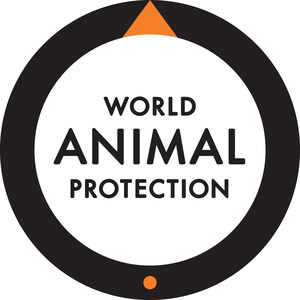NEW YORK, April 19, 2021 /PRNewswire/ -- According to new research by World Animal Protection, a global animal welfare nonprofit organization, public waterways next to factory farms contain antibiotic resistance genes (ARG)—the building blocks of superbugs—that may pose a risk to public health.
The study provides new evidence of the presence of antibiotic resistance in the environment near large factory farms in the US, suggesting intensive farms could be polluting local waterways and communities with resistant bacteria as a result of their practices. Differences in sample results taken downstream compared to upstream suggest the target farm sites are contributing to the contamination of ARGs.
Antibiotics are routinely used in factory farms to mask poor welfare and prevent stressed animals from getting sick. The animals are often confined to cages or barren concrete pens, endure painful physical mutilations and are taken from their mothers too young. ARGs are the building blocks of superbugs—bacteria resistant to the antibiotics used to fight them—that emerge and spread rapidly due to antibiotics overuse.
World Animal Protection's investigation tested samples of water and soil collected in an area of North Carolina heavily concentrated with large factory farms. Samples were taken both downstream and upstream from target farm operations. However, the high density of pig and poultry farms in the area means that upstream sample sites may be regularly impacted by discharges from farms further upstream.
"The implications of antibiotic resistance throughout the environment near large factory farms are extremely concerning," says Cameron Harsh, Farming Campaign Manager, World Animal Protection US. "The contamination of waterways and air puts nearby communities at high risk. Drug residues and resistant bacteria do not obey the boundaries of the farm operation. They are carried away via the waste stored in lagoons or sprayed on fields, on insects, rodents, and other wildlife, on farmworkers headed home to their families, and on the animals processed for our food, potentially spreading resistance to other bacteria as they persist and travel."
The new report reveals very wide evidence of ARGs conveying resistance to streptomycin, fluoroquinolones, cephalosporins, macrolides, and most broadly, tetracycline. In particular:
- All 45 water samples and all 45 soil samples taken across eight sample sites returned a positive result for at least one antibiotic resistance gene.
- 92% of samples had positive results for three or more different resistance genes, with the largest number of genes in a single sample being ten.
Genes conveying resistance to tetracycline drugs were identified in nearly all samples (89/90), and roughly half of samples were positive for three or more different tetracycline-resistance genes. According to 2019 data, tetracyclines were the largest class of drug sold by volume in the US for use in farmed animals, and the pork industry accounted for 50% of these sales. Data from producer surveys indicate that tetracyclines account for 60% of total antibiotics used by US pork producers. - Genes related to extended-spectrum β-lactamase (ESBL)-producing bacteria (which includes Salmonella, E. coli, and Klebsiella) were identified in one in four samples. Their prevalence near swine farms has been previously reported, and the World Health Organization (WHO) identifies them as a global threat. The genes can convey resistance to cephalosporin, penicillin, and carbapenem antibiotics. Carbapenems and some cephalosporins are considered antibiotics of last resort.
- Genes conveying resistance to aminoglycoside, amphenicol, and macrolide antibiotics were found in a larger number of downstream than upstream samples. Macrolide antibiotics are categorized as Highest Priority Critically Important Antimicrobials by WHO.
According to the Centers for Disease Control and Prevention (CDC), each year in the US alone, 2.8 million people get an antibiotic-resistant infection and more than 35,000 die. Economists have projected that, if nothing is done to address business-as-usual, by 2050, antibiotic resistance will cause 10 million deaths each year and cause USD $100 trillion in global economic losses.
Animal waste and other contaminants containing ARGs, superbugs, or drug residues can be carried off-farm in a variety of pathways that directly or indirectly reach people. Manure stored in lagoons or sprayed on fields can leach into groundwater and public waterways. Particulate matter released into the air can settle on the soil and vegetation nearby. Farmworkers, insects, rodents, wild birds, and farmed animals headed to slaughter may all carry ARGs or superbugs with them.
World Animal Protection conducted similar testing of water and soil samples collected near to factory farms in Canada, Spain, and Thailand. ARGs conveying resistance to important medicines were identified in all countries, including resistance to cephalosporins and fluoroquinolones. This cross-country research is the first of its kind and adds to the mounting evidence of public health harms attributed to intensive livestock production. Testing in Canada found ARGs resistant to tetracycline, streptomycin, cephalosporins, fluoroquinolones, and macrolides in surface water and sediments. In Spain, testing found ARGs resistant to tetracycline, sulfonamides, cephalosporins, and fluoroquinolones. ARGs from surface water samples were up to 200 times higher than the baseline levels. And in Thailand, results showed ARGs and superbugs resistant to third-generation cephalosporins, fluoroquinolones, or colistin plus co-trimoxazole, gentamicin, amikacin, trimethoprim-sulfamethoxazole, or amoxicillin.
In 2019, World Animal Protection documented antibiotic-resistant bacteria—also called "superbugs"—on pork sold at Walmart stores in the US Eighty-one percent of bacteria—including E. coli, Salmonella, Listeria, and Enterococcus—isolated from the pork samples were resistant, and 38% were multidrug-resistant, meaning they had resistance to three or more classes of antibiotics.
Notes to Editors
- Superbugs are antibiotic-resistant bacteria and have been called one of the biggest threats to global health and development. The overuse of antibiotics has led to the spread of superbugs and impacts millions of people around the world, especially in developing countries. Seven hundred thousand people worldwide die each year from antibiotic-resistant infections, and this is projected to rise to 10 million deaths annually by 2050.
- The United Nations Environment Programme has acknowledged that antibiotics are used to mask low welfare conditions on farms and called for an end to unsustainable agricultural practices and more investment in sustainable, agroecological systems1.
- A 2020 poll commissioned by World Animal Protection across 15 countries found that 88% of people are concerned about superbugs from farmed animals, and want animals treated well. Two-thirds of people would help test for pollution from farms to hold big business to account.
- There is no international standard describing the concentration at which superbugs in the environment become dangerous to people. Consequently, no one is being held responsible, and farm discharge of antibiotics and superbugs into waterways are unmonitored.
Key outcomes from each country from the investigation
Canada |
Testing found ARGs resistant to tetracycline, streptomycin, cephalosporins, fluoroquinolones, and macrolides in surface water and sediments. |
Spain |
Testing found ARGs resistant to tetracycline, sulfonamides, cephalosporins, and fluoroquinolones. ARGs from surface water samples were up to 200 times higher than the baseline levels. Extremely high levels of ARGs were found in dust samples collected adjacent to farms. Testing of groundwater near farms also revealed very high levels of ARGs. |
Thailand |
Testing of water and sediment found ARGs and superbugs resistant to third-generation cephalosporins, fluoroquinolones, or colistin plus co-trimoxazole, gentamicin, amikacin, trimethoprim-sulfamethoxazole, or amoxicillin. |
USA |
Testing of water and sediment or soil found very wide evidence of ARGs conveying resistance to streptomycin, fluoroquinolones, cephalosporins, macrolides, and most broadly, tetracycline. |
1 United Nations Environment Programme, Preventing the next pandemic: Zoonotic diseases and how to break the chain of transmission. 2020.
SOURCE World Animal Protection

Related Links
http://www.worldanimalprotection.us.org
WANT YOUR COMPANY'S NEWS FEATURED ON PRNEWSWIRE.COM?
Newsrooms &
Influencers
Digital Media
Outlets
Journalists
Opted In





Share this article